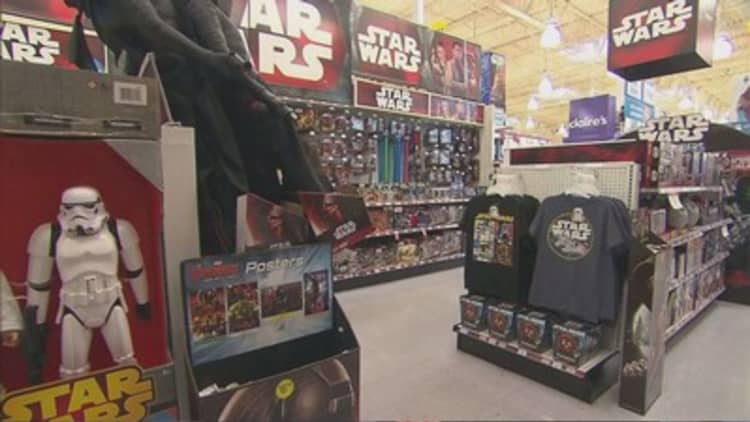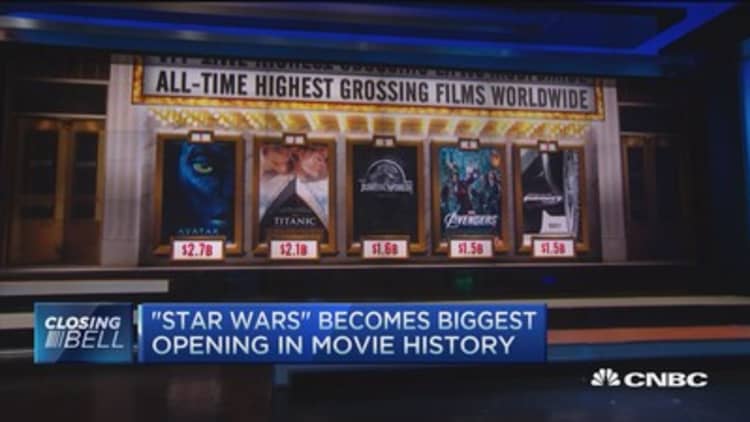
The latest installment in the "Star Wars" franchise not only smashed box-office records and burnished Disney's reputation as a media giant with a keen eye for acquisitions. The blockbuster also provided a fillip to the otherwise sluggish toy industry, analysts say.
Lightsabers, First Order Star Destroyer, and remote controlled Millennium Falcon Quads are some of the newest "Star Wars" toys to have hit the shelves this year as Disney released the first movie in a decade from the beloved franchise.
"Star Wars: The Force Awakens" has already secured the best box office opening weekend ever domestically, with an estimated $238 million in the U.S. Including international sales, the movie has generated $517 million so far. In box office history, only two films have grossed over $2 billion: Avatar ($2.8 billion) and Titanic ($2.19 billion).
Some experts think the popularity of this franchise, along with demand for its merchandise, might offer a small respite for traditional toys and games, which have been on the decline for years as children turn to digital means of entertainment.
Traditional toys comprise a broad category of items, including board games, action figures, dolls, puzzles, wooden toys, and even bulkier items such as bicycles and tricycles.

A report from IHS Maritime & Trade said containerized toy imports to the U.S. are expected to increase by 10.9 percent on-year by the end of 2015. That's an equivalent of 581,053 20-feet long shipping containers worth of toys, boosted by demand for Star Wars merchandise.
"It will be a positive growth of 11 percent over 2014 volumes," said Mario Moreno, the report's author, and a senior economist at IHS Maritime & Trade.
It wasn't all due to 'Star Wars' though. A growth in children population also played a part in the rise in demand, Moreno said.
The report noted toy imports to the U.S. saw consecutive on-year declines between 2011 and 2013, before seeing a 3.5 percent uptick in 2014.
Mykola Golovko, senior analyst for Toys & Games at Euromonitor said in a note earlier this year, "The highly-anticipated ["Star Wars" feature film] has precipitated an unparalleled array of licensed products spanning toys, apparel, housewares, even jewelry."

Licensed toys are usually attached to mega franchises. One example is Disney's 2013 animated film Frozen, which was one of the most sought-after licensed properties for toys and games. Though the film was released towards the end of 2013, the demand for Frozen merchandise remained strong into 2014.
A Toys"R"Us spokesperson told CNBC by email that Star Wars merchandise has always been an "evergreen perennial favorite" among its customers. "Shoppers can find dedicated Star Wars destinations in all Toys"R"Us stores nationwide (the majority of stores feature 100 square feet of linear shelf space), offering a one-stop-shop for Star Wars figures, construction sets, accessories and more," the spokesperson added.
In September, Disney launched 'Force Friday', where merchandise from "Star Wars: The Force Awakens" went on sale globally. It was preceded by a global live unboxing event broadcasted on YouTube from 15 cities around the world, where highlights of the new product range were officially unveiled.
Moreno said demand for "Star Wars" merchandise will remain in 2016. "If we look back a year ago, the same thing happened with Disney's Frozen gear," he said, adding the first half of 2015 still saw sizable demand for Frozen merchandise.
But for traditional toys and games to replicate a similar, two-figure demand like in 2016 will be a tall order, according to Moreno, unless Disney, or a different producer, comes out with another blockbuster movie.
One of the factors constraining the growth of traditional toys is the advancement in technology, he said.
"Nowadays, children not only in the U.S., but all over the world, play games on tablets and game consoles," he said, as opposed to playing with traditional items such as board games and action figures.
Data compiled by Euromonitor forecasts traditional toys and games in the U.S. will reach a retail value of $22.4 billion by end of 2015. By 2019, it will increase to a modest $23.4 billion.
On the other hand, the video games market will catch up, growing from $20.1 billion in 2015 to $22.6 billion by 2019.
"The best growth we're going to be seeing for toy imports next year is probably going to be in the low single digits," Moreno added.


